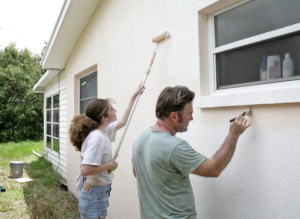Home Improvements are used to describe renovations or additions to a residential property. It can include anything from a kitchen remodel to replacing flooring.

The key to successful home improvement is to know which projects will increase a home’s value. Kitchen and bathroom renovations are always popular choices, as are landscaping improvements.
Home improvement is a multibillion-dollar industry that has been experiencing excellent growth results in recent years. This market encompasses the sale of building materials, appliances, decor, and furnishings and the construction and installation of improvements to residential property. It is important that any homeowner or contractor takes the necessary precautions when working on any project to ensure the safety of themselves and others. This is especially true when electrical work or plumbing are involved.
When hiring a contractor to perform a home improvement project, it is vital that they are properly licensed and insured. This will protect the homeowner from liability if an accident occurs while they are performing a job on their property. It is also recommended that homeowners compare several different contractors in terms of price, experience and reputation before making a final decision.
Depending on the scope of the work, there may be a need to obtain permits from local authorities. This will require the contractor to submit copies of their permit application and a copy of their contractor’s license before starting any work. In addition, any contract signed by a contractor should have their name, address and MHIC license number preprinted on it. This will help to prevent any fraudulent activities from taking place during a home improvement project. Also, it is important that the homeowner understands what they are signing up for and does not allow their contractor to make any sudden changes to their original plans.
Get a Well-Planned Budget
Home improvement can be expensive, so it’s important to plan your renovation carefully. This will help you stay within your budget and get the best results from your project. Start by getting cost estimates from contractors and other sources. Then create a spreadsheet to breakdown all of the individual components of your project. This will help you see exactly how much each item costs so you can avoid surprises down the road.
It’s also important to consider your return on investment (ROI). Some projects can really increase your home’s value, while others may not pay off in the long run. There are a number of websites that can give you an idea of the ROI for different home improvements. Once you know which ones will be worth the money, it’s time to start saving!
Another thing to keep in mind is that it’s generally best to pay for home improvements with cash instead of credit. This will save you a lot of money in interest charges down the road. If you don’t have the money saved, try setting a savings goal that will allow you to complete your renovation project in cash.
Finally, it’s a good idea to take a look at what other homes in your neighborhood are selling for and what design trends are popular in your area. If you follow these tips, you’ll be able to improve your home in ways that will add value and make it more appealing to potential buyers.
Choose the Right Materials
One of the most important aspects of a home improvement project is choosing the right materials. Not only does this affect the cost and appearance of the project, but it also determines how durable, sustainable, and functional the final product will be. This is why it is essential to do your research and consult with professionals before making any decisions. Contractors, designers, and even store employees can help you make the best choices by explaining the pros and cons of each option. They can also provide recommendations based on their own experience with specific products or projects.
When selecting the materials for your renovation, consider how long you plan to own your house and what sort of maintenance you’re willing to do. It’s a good idea to choose durable and low-maintenance materials that will last for years without requiring extensive upkeep.
You should also take into consideration the climate where you live. Some materials are better suited for certain environments, depending on things like temperature, rainfall, wind, and soil strength. For example, salty ocean breezes can quickly shorten the lifespan of some materials, while heavy snow or rain can cause water damage if it seeps through the roof.
If you’re renovating an existing space, it’s also worth considering how the new materials will complement the original design of the room. This will ensure a consistent look and feel throughout the entire house, and it will avoid any clashes or mismatches that can detract from the overall appearance of the property.
It’s also a good idea to compare prices before purchasing any materials. It’s possible that you can save money by buying materials in bulk, or taking advantage of discounts or sales. You can also ask your contractor or designer about any upcoming deals that they may know about. This can help you save a significant amount on your renovation costs without sacrificing quality or performance.
Get Professional Help
Home improvement can be a great way to add value to your home, but it’s important to know when to ask for professional help. A qualified contractor can ensure that your home improvement project is done correctly and safely, while saving you time and money.
Before hiring a contractor, you should always check their credentials and licenses. It’s also a good idea to get a written contract for any work that is performed. This will protect you in case something goes wrong with the project or you don’t like the results. It’s also a good idea not to hire contractors that don’t have a valid business license or insurance.
